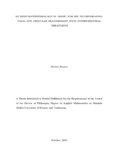| dc.contributor.author | Mobisa, Benson | |
| dc.date.accessioned | 2020-12-11T07:18:40Z | |
| dc.date.available | 2020-12-11T07:18:40Z | |
| dc.date.issued | 2019-10-13 | |
| dc.identifier.uri | http://r-library.mmust.ac.ke/123456789/1434 | |
| dc.description.abstract | Mathematicians have made various attempts to understand the dynamical behaviour of HIV and AIDS using within-and between-host transmission models. Since the mechanismof HIV and AIDS transmission is an intricate process, treating these processes separatelymay not comprehensively unravel the many properties that can emerge as a result of theinterdependence of the two transmission processes. Hence a paradigm shift on modellingis fundamental in generating new predictions and strategies for controlling HIV spread.In view of this, multiscale models for HIV and AIDS are key in addressing this gap.Existing immuno-epidemiological models for HIV and AIDS however do not incorporate treatment in the viral and cellular transmission paths. This study focused on developingan immuno-epidemiological model for HIV and AIDS, incorporating viral and cellulartransmission with antiretroviral treatment. Using ordinary differential equations, the two transmission subsystems were coupled in which the transmission rate at the populationwas expressed as a function of the viral load, while the within-host infection rates were modelled as functions of the number of infectives. The basic reproduction number,R0Cof the coupled model was found to be a maximum of the two reproduction numbersR0BandR0Wcorresponding to the between host and within host subsystems respectively.Stability analysis revealed that the disease free equilibrium is globally asymptoticallystable wheneverR0B<1 andR0W<1. Theoretically this means that the disease iswiped out. Using the center manifold Theorem, the endemic equilibrium was found tobe locally asymptotically stable ifR0C>1 and unstable otherwise. This reveals that thehigh transmissibility of HIV caused by high viral load at the within host level will leadto disease persistence in the population. Numerical simulation shows that an increase inviral load at the within host level leads to proportional increase in the number of infectivesat the population level. The effectiveness of ARV treatment in combating the spread ofHIV and AIDS depends on the efficacy levels of both RTI and PI. Consequently the studyrecommends the administration of ARVs with high treatment efficacy for both RTI andPI levels. | en_US |
| dc.description.sponsorship | MMUST | en_US |
| dc.language.iso | en | en_US |
| dc.publisher | MMUST | en_US |
| dc.subject | Immuno-epidemiological, Viral, Cellular, HIV and Aids, Incorporate, treatment, transmission | en_US |
| dc.title | AN IMMUNOEPIDEMIOLOGICAL MODEL FOR HIV INCORPORATINGVIRAL AND CELLULAR TRANSMISSION WITH ANTIRETROVIRALTREATMENT | en_US |
| dc.type | Thesis | en_US |

